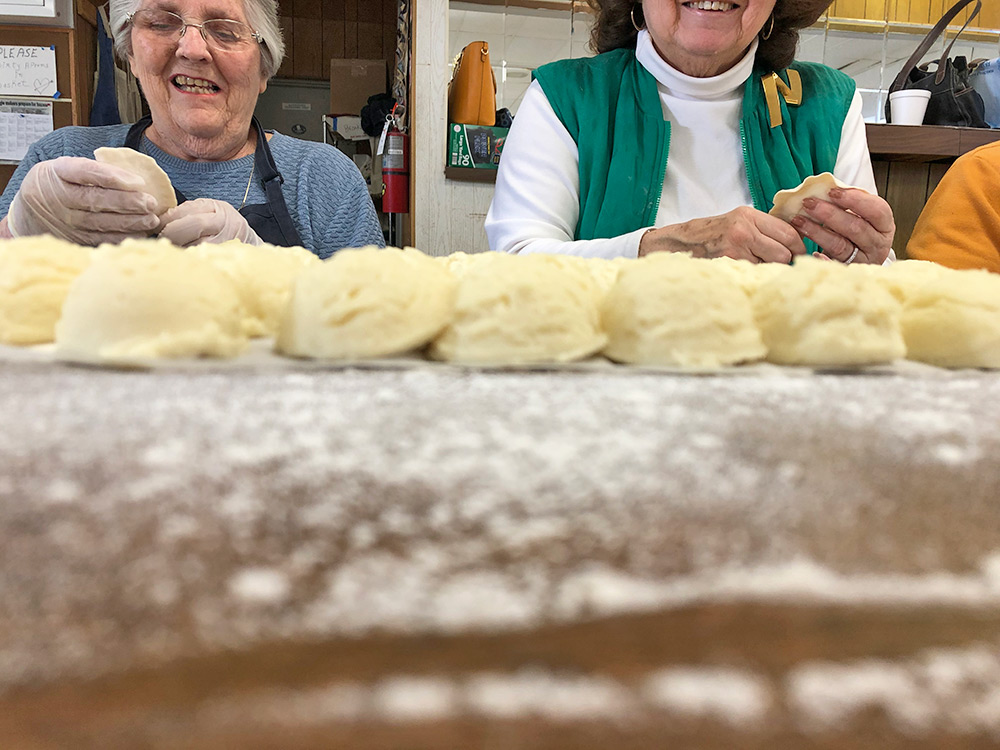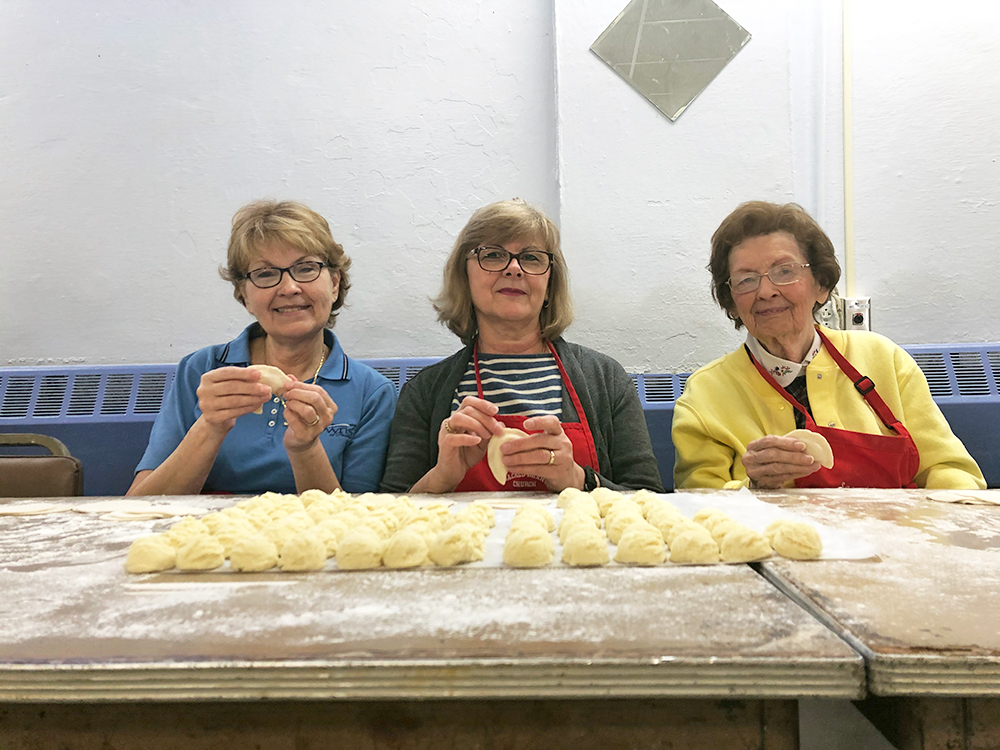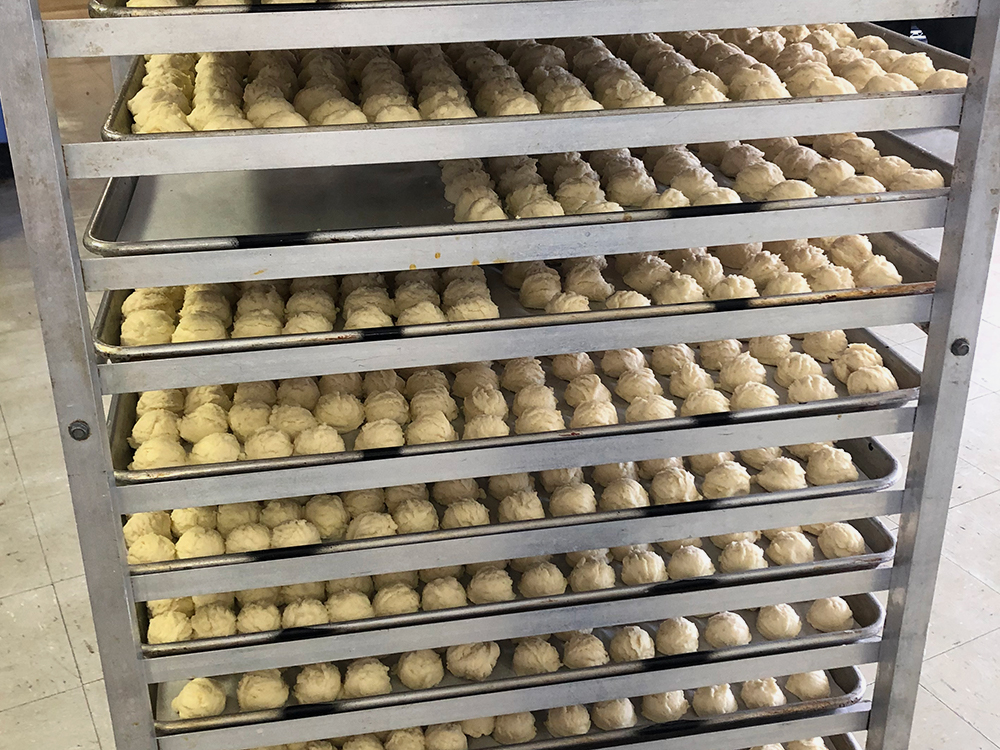Christians of various denominations will give up certain luxuries for Lent, but in Pennsylvania, they’re not giving up the annual pierogi tradition — at least not on purpose. Jenna Spinelle went to the one of the biggest pop-up pierogi operations in the state to see what the future holds for this community-powered tradition.
Throughout Lent — the six weeks between Ash Wednesday and Easter — the basements of Catholic churches across Pennsylvania are filled with pinchers, ballers and baggers.
As they work, they discuss their families, tell stories from their younger days, and vent about things they might not share otherwise. What happens at pierogi making, stays at pierogi making. The end result is a few hundred — or in some cases a few thousand — perfectly-shaped dough pockets filled with potatoes and cheese that are ready to boil and, if you’re feeling extra decadent, pan- or deep-fry.
In the Catholic tradition, it’s common to refrain from eating meat on Fridays during Lent, but pierogi are fair game. If you’ve only experienced pierogi out of the bright blue Mrs. T’s box, you have no idea what you’re missing. I grew up with this tradition as a Catholic in eastern Pennsylvania. We would eat pierogi at my grandmother’s house most Fridays during Lent. I can still smell the browned butter that wafted out from her kitchen and the contrast between the crunch of the dough and the softness of the filling inside it.
I’m not a practicing Catholic these days, but still find myself nostalgic for the church’s traditions and the food that comes with them. On a Thursday morning in early March, I joined about 50 volunteers gathered in the basement/recreation center of Saint Elizabeth Anne Seton Parish in Swoyersville, one of the largest pierogi operations in eastern Pennsylvania.
It looks like any other church from the outside, but the heart of the operation is in its basement, equipped with a full, semi-commercial kitchen that’s also used for breakfasts, bingo nights, and other church functions throughout the year. This is fairly common among churches in this area; food is a big source of income and community for the parish outside of weekly Mass.
Running the pierogi show was Rich Nemetz, who is both a former bakery owner and head of the pastry department at nearby Luzerne County Community College. In other words, he knows his way around some dough.
With clockwork-like precision, the dough was rolled out into sheets that were at least 2-3 feet long and cut into rounds by a long silver roller lined with circular molds — picture a cookie cutter on steroids. The rounds are divided up among the rows of pinchers, who fill them with pre-rolled balls of potato and cheese filling and crimp the ends together like an empanada.

A smaller group of volunteers arrives an hour earlier to prepare the filling so it’s ready to be scooped and pinched. Once their pierogi are prepared, they’re counted by the dozen and placed into plastic bags for sale or delivery.
The end result for that day’s work is 7200 pierogi, or 600 dozen as Nemetz likes to think of it. Most of the orders are received in advance, but some will be sold at the church the next day. In the Catholic tradition, it’s common to refrain from eating meat on Fridays during Lent, the six weeks between Ash Wednesday and Easter.
While Saint Elizabeth Ann Seton is the largest pierogi-making operation in the region, it’s far from the only one. In fact, several of its volunteers also make pierogi at other churches and move around to help keep the tradition alive in as many places as possible.
Churches quibble over who makes the best dough or has the fluffiest potato filling, but in the end, everyone is committed to the tradition and what it signifies: people coming together to make food that’s part of their heritage and help maintain a connection to each other and to their faith.

Bernadine “Dinie” Radici and Doreen Kozak are two members of this pierogi brigade. They also volunteer at Saint Faustina Parish in Nanticoke and Sacred Heart Parish in Dupont. On the day I visited Saint Elizabeth Ann Seton, they were accompanied by Radici’s mother, Ceila Wrazien, who calls pierogi pinching the secret to her longevity.
As I walked around talking with volunteers, I had to be careful not to slip on the flour that quickly coated the floor and be careful not to get in the way when the runners came by to deliver more dough rounds to the pinchers.
Most of the people I spoke with at Saint Elizabeth Ann Seton were over the age of 60 and in some stage of retirement. Volunteer Arlene Straub told me that the pierogi makers occasionally receive help from students doing volunteer projects or meeting school community service requirements, but the bulk of the work continues to be by older generations.
A theme among everyone I talked with was uncertainty about if and how the tradition will continue as the church’s congregation becomes older. According to the Pew Research Center, the percentage of Americans who identify as Catholic continues to decline, as does church attendance, particularly among Millennials and Generation Z.
Places like Swoyersville in northeastern Pennsylvania are also victim to faltering economies and the brain drain that makes young people leave and never come back. If nothing changes, many worry the tradition will slowly fade away in the coming years as volunteers become too old to work, and the church can no longer afford the supplies necessary to make pierogi in the first place.
It might not be next year, but it’s going to happen sometime. Will anyone notice, and will anyone care? I hope so, and so did everyone I talked with.

If you’re reading this and wondering whether it’s possible to get homemade pierogi for Easter, the answer is probably not, unfortunately. After my visit, the 2020 pierogi season ended abruptly when COVID-19 came to town. It’s a common practice to freeze pierogi for later use, but like toilet paper and hand sanitizer, those resources are likely long depleted by now.
The jury is, of course, still out on what the lasting impacts of COVID-19 will be, but if current trends are any indication, traditions like this one are not going to fare well. As I write this in early April, northeastern Pennsylvania is seeing a sharp increase in new confirmed cases each day. I think about the people I met on my visit when I read those reports and pray that they’re all ok.
Coronavirus aside, the Slack groups, boozy brunches, and networking events that seem to be the most common social activities among my generation are just not the same as coming together for a shared purpose that benefits the greater good.
Maybe COVID-19 will make us realize how valuable these connections are to our social fabric and renew civic participation. Or maybe it will accelerate the demise as we grow even more used to living our lives online. I hope for the former, but fear the latter might very well be true.
An even bigger question looming on the horizon for churches across Pennsylvania is whether they will be able to have their annual bazaars — outdoor carnivals filled with homemade food, polka music, and quasi-legal games of chance.
The one-two punch of missed pierogi sales and canceled bazaars will be a lot for churches to absorb, but again, the answers about what the future holds are unclear right now.
Either way, I’m glad I had the opportunity to spend a few hours in those precious pre-COVID days with these volunteers before the days of social distancing.
The end of Lent is an interesting time to reflect on what we choose to give up in our lives. Small towns like Swoyersville are filled with traditions like pierogi making that are in danger of being erased from our hearts and minds.
I can’t speak for all of those traditions, but I know this one is far too delicious to let go.
You may not be able to get your hands on pierogi in Pennsylvania or elsewhere this year, but there are plenty more Statesider original stories to enjoy whenever you need one.
All photos by Jenna Spinelle, © 2020
